Energy Retrofitting Opportunities Using Renewable Materials—Comparative Analysis of the Current Frameworks in Bosnia-Herzegovina and Slovenia
Abstract
1. Introduction
2. Strategies and Legislation Developed and Implemented in Bosnia-Herzegovina and Slovenia
2.1. Bosnia-Herzegovina Case
2.2. Slovenia Case
3. Discussion of Bosnia-Herzegovina and Slovenia Cases
4. Overview on European Policy Landscape Related to Energy Retrofitting Opportunities
5. Analysis of the Barriers Preventing Wider Use of Renewable Materials
6. Conclusions
Author Contributions
Funding
Acknowledgments
Conflicts of Interest
References
- Felius, L.; Mohamed, H.; Dessen, F.; Hrynyszyn, B.D. Upgrading the Smartness of Retrofitting Packages towards Energy-Efficient Residential Buildings in Cold Climate Countries: Two Case Studies. Buildings 2020, 10, 200. [Google Scholar] [CrossRef]
- EUROSTAT. Energy Efficiency in Buildings. Available online: https://epthinktank.eu/2016/07/08/energy-efficiency-in-buildings/ (accessed on 22 January 2020).
- Lucon, O.; Urge-Vorsatz, A.; Zain Ahmed, A.; Akbari, H.; Bertoldi, P.; Cabeza, L.; Eyre, N.; Gadgil, A.; Harvey, L.; Jaing, Y. Buildings. Chapter 9. In Climate Change 2014: Mitigation of Climate Change; Contribution of Working Group III to the Fifth Assessment Report of the Intergovernmental Panel; The Intergovernmental Panel: Cambridge, UK; New York, NY, USA, 2014; pp. 678–679. [Google Scholar]
- Guo, H.; Liu, Y.; Chang, W.-S.; Shao, Y.; Sun, S. Energy Saving and Carbon Reduction in the Operation Stage of Cross Laminated Timber Residential Buildings in China. Sustainability 2017, 9, 292. [Google Scholar] [CrossRef]
- Soutullo, S.; Giancola, E.; Sanchez, M.N.; Ferrer, J.A.; Garcia, D.; Suarez, M.J.; Prieto, J.I.; Antuna-Yudego, E.; Carus, J.L.; Fernandez, M.A.; et al. Methodology for Quantifying the Energy Saving Potentials Combining Building Retrofitting, Solar Thermal Energy and Geothermal Resources. Energies 2020, 13, 5970. [Google Scholar] [CrossRef]
- Masson-Delmotte, V.; Zhai, P.; Portner, H.-O.; Roberts, D.; Skea, J.; Shukla, P.; Pirani, A.; Moufouma-Okia, W.; Pean, C.; Pidcock, R. GW of 1.5 °C. IPCC Special Report on the Impacts of Global warming of 1.5 °C above Pre-Industrial Level & Related Global GHG Emissions. In Pathways, in the Context of Strengthening the Global Response to the Threat of Climate Change, Sustainable Development & Efforts to Eradicate Poverty; IPCC—International Panel for Climate Change: Geneva, Switzerland, 2018; Available online: https://www.ipcc.ch/sr15 (accessed on 26 June 2020).
- European Comission 2018 Buildings. 2018. Available online: https://ec.europa.eu/energy/en/topics/energy-efficiency/energy-performance-of-buildings/overview (accessed on 2 December 2020).
- Rahmawati, Y.; Utomo, C.; Sukri, N.S.M.; Yasinta, R.B.; Al-Aidrous, A.-H.M.H. Environmental Enhancement through High-Rise Building Refurbishment. Sustainability 2020, 12, 9350. [Google Scholar] [CrossRef]
- Hu, M. Cost-Effective Options for the Renovation of an Existing Education Building toward the Nearly Net-Zero Energy Goal—Life-Cycle Cost Analys. Sustainability 2019, 11, 2444. [Google Scholar] [CrossRef]
- Gajić, D.; Stupar, D.; Janković, A. Determination of the energy performance indicator of kindergartens through design, measured and recommended parameters. Energy Build. 2019, 204, 109511. [Google Scholar] [CrossRef]
- Mecca, U.; Moglia, G.; Piantanida, P.; Prizzon, F.; Rebaudengo, M.; Vottari, A. How Energy Retrofit Maintenance Affects Residential Buildings Market Value? Sustainability 2020, 12, 5213. [Google Scholar] [CrossRef]
- Piccardo, C.; Dodoo, A.; Gustavsson, L.; Tettey, U. Retrofitting with different building materials: Life-cycle primary energy implications. Energy 2020, 192, 116648. [Google Scholar] [CrossRef]
- Petrillo, M.; Sandak, J.M.; Grossi, P.; Kutnar, A.; Sandak, A.M. Long service life or cascading? The environmental impact of maintenance of wood-based materials for building envelope and their recycling options. In Proceedings of the IRG49 Scientific Conference on Wood Protection, Johannesburg, South Africa, 29 April–3 May 2018. [Google Scholar]
- Kutnar, A.; Hill, C. Life cycle assessment—Opportunities for forest products sector. Bioprod. Bus. 2018, 2, 52–64. [Google Scholar]
- Kutnar, A. Wood Architecture in Slovenia for sustainable development: Panorama of the most representative construction sites; in Forum Bois Construction. In Proceedings of the 5ème Forum International Bois Construction, Epinal, Nancy, France, 15–17 April 2015. [Google Scholar]
- Kunič, R.; Tavzes, Č.; Kutnar, A. Ogljični odtis toplotnoizolacijskih materialov v toplotnem ovoju stavb. Gradb. Vestn. 2012, 61, 206–214. [Google Scholar]
- Forest Area (% of Land Area)—Bosnia and Herzegovina, Slovenia; The World Bank—IBRD-IDA. Available online: https://data.worldbank.org/indicator/AG.LND.FRST.ZS?end=2016&locations=BA -SI&start=2016&view=bar (accessed on 30 November 2020).
- Production, Sales and Stocks of Forest Assortments in Bosnia and Herzegovina in 2019. Available online: http://www.bhas.ba/data/Publikacije/Saopstenja/2020/FOR_03_2019_Y1_0_SR.pdf (accessed on 30 November 2020).
- European Parliament; Council Directive 2012/27/EU of 25 October 2012 on Energy Efficiency (European Union). 2012. Available online: https://eur-lex.europa.eu/legal-content/EN/TXT/?uri=celex%3A32012L0027 (accessed on 5 February 2020).
- Ugovor o Uspostavi Energetske Zajednice (Eng. The Contract of Energy Community Establishment.); Predsjedništvo Bosne i Hercegovine; (Bosna and Herzegovina Presidency). 2006. Available online: https://www.nosbih.ba/files/dokumenti/Legislativa/EU/BIH/Energetska%20zajednica_BOS.pdf (accessed on 1 February 2020).
- Dolgoročna Strategija za Spodbujanje Naložb Energetske Prenove Stavb. (Eng. Long-Term Strategy for Promoting Energy Renovation of Buildings). Available online: https://www.energetika-portal.si/dokumenti/strateski-razvojni-dokumenti/dolgorocna-strategija-za-spodbujanje-nalozb-energetske-prenove-stavb/ (accessed on 18 February 2020).
- Nacrt Strategije Obnove Zgrada u Republici Srpskoj do 2050. Godine. (Eng. Draft of Building Renovation Strategy in Republic of Srpska till 2050); Ministry for Spatial Planning, Governement of Republic of Srpska: Banja Luka, Republic of Srpska, Bosnia and Herzegovina, 2019.
- Okoljska Dekleracija Proizvoda. Available online: https://www.zag.si/si/certifikati-soglasja/sluzba-za-tehnicne-ocene-in-soglasja/okoljska-dekleracija-proizvoda (accessed on 20 February 2020).
- Uredbo o Zelenem Javnem Naročanju. 2017. Available online: http://www.pisrs.si/Pis.web/pregledPredpisa?id=URED7202 (accessed on 20 February 2020).
- International Energy Agency 2018. 2018. Available online: https://www.iea.org/ (accessed on 20 September 2020).
- Energy Statistic. 2015. Available online: http://www.bhas.ba/saopstenja/2015/APED_2015_001_01_BA.pdf (accessed on 30 September 2016).
- Energetski bilans Republike Srpske–plan za 2010. godinu (Eng. Energy Balance for the Republic of Srpska—Plan for 2010); Ministry of Energy and mining, Government of the Republic of Srpska: Banja Luka, Republic of Srpska, Bosnia and Herzegovina, 2010.
- Energetski bilans Republike Srpske – plan za 2019. godinu (Eng. Energy Balance for the Republic of Srpska–Plan for 2019); Ministry of Energy and mining, Government of the Republic of Srpska: Banja Luka, Republic of Srpska, Bosnia and Herzegovina, 2019.
- Energy statistics: Short-Term Indicators of Energy Statistics. 2019. Available online: http://www.bhas.gov.ba/data/Publikacije/Saopstenja/2019/ENE_01_2019_03_0_BS.pdf (accessed on 20 September 2020).
- Arnautović Aksić, D.; Burazor, M.; Delalic, N.; Gajić, D.; Gvero, P.; Kadrić, D.; Kotur, M.; Salihović, E.; Todorović, D.; Zagora, N. Typology of Residential Buildings in Bosnia and Herzegovina; Deutsche Gesellschaft für Internationale Zusammenarbeit (GIZ): Bonn, Germany; University of Sarajevo: Sarajevo, Bosnia and Herzegovina; University of Banja Luka: Banja Luka, Srpska, 2016. [Google Scholar]
- Nišandžić, M. Tipologija Javnih Zgrada u Bosni i Hercegovini (Eng. Typology of Public Buildings in Bosnia and Herzegovina); UNDP in Bosnia and Herzegovina: Sarajevo, Bosnia and Herzegovina, 2017. [Google Scholar]
- Gajić, D.; Salihović, E.; Zagora, N. Estimate of Energy Performance Indicator of Existing Single-Family Houses in Bosnia and Herzegovina. In Handbook of Research on Urban-Rural Synergy Development through Housing, Landscape and Tourism; IGI Global: Harshey, PA, USA, 2020; pp. 244–260. [Google Scholar]
- Cost-Optimal Analysis of Residential Buildings in Bosnia and Herzegovina with Testing of New Climate Data for Residential and Non-Residential Buildings; Deutsche Gesellschaft für Internationale Zusammenarbeit (GIZ): Bonn, Germany, 2017.
- Energy Balance for Slovenia in 2019, Republic of Slovenia, Statistical Office. 2020. Available online: https://www.stat.si/StatWeb/en/News/Index/9109 (accessed on 1 December 2020).
- Energy Act. Governement of Republic of Slovenia. 2014. Available online: http://www.pisrs.si/Pis.web/pregledPredpisa?id=ZAKO6665 (accessed on 5 February 2020).
- Environmental Protection Act. Governement of Republic of Slovenia. 2004. Available online: http://www.pisrs.si/Pis.web/pregledPredpisa?id=ZAKO273 (accessed on 5 February 2020).
- Eko sklad, Slovenski javni okoljski sklad. Available online: https://www.piran.si/index.php?page=static&item=586 (accessed on 5 February 2020).
- Decree on Energy Savings Requirements. Governement of Republic of Slovenia. 2014. Available online: http://www.pisrs.si/Pis.web/pregledPredpisa?id=URED6636 (accessed on 5 February 2020).
- Akcijski Načrt za Skoraj nič Energijske Stavbe za Obdobje do Leta 2020 (Eng. Action Plan for Nearly Zero Energy Buildings 2015). Governement of Republic of Slovenia. 2015. Available online: https://www.energetika-portal.si/fileadmin/dokumenti/publikacije/an_snes/ansnes_final_apr_2015 pdf (accessed on 5 February 2020).
- Borzen, Center za Podpore. Available online: https://www.borzen.si/sl/Domov/menu2/Center-za-podpore-proizvodnji-zelene-energije/Predstavitev-centra-za-podpore (accessed on 20 February 2020).
- Akcijski Načrt za Učinkovito Rabo Energije do Leta 2020. 2014. Available online: https://www.energetika-portal.si/fileadmin/dokumenti/publikacije/an_ure/an_ure_2017-2020_final.pdf (accessed on 20 February 2020).
- Dolgoročna Strategija za Spodbujanje Naložb v Energetsko Prenovo Stavb (DSEPS). 2015. Available online: https://www.energetika-portal.si/fileadmin/dokumenti/publikacije/dseps/dseps_final_okt 2015.pdf (accessed on 20 February 2020).
- Rules on Efficient Use of Energy in Buildings 2010. Available online: http://www.pisrs.si/Pis.web/pregledPredpisa?id=PRAV10043 (accessed on 5 March 2020).
- Decree on Green Public Procurement 2017. 2017. Available online: http://www.pisrs.si/Pis.web/pregledPredpisa?id=URED7202 (accessed on 5 March 2020).
- Operativni Program Ukrepov za Zmanjšanje Izpustov Toplogrednih Plinov do Leta 2020 (Eng. Operational Programme for Reducing Greenhouse Gas Emissions until 2020). Available online: https://www.energetika-portal.si/fileadmin/dokumenti/publikacije/op_tgp/op_tgp_2020.pdf (accessed on 5 March 2020).
- Decision No. 406/2009/EC of 23 April 2009 on the Effort of Member States to Reduce Their Greenhouse Gas Emissions to Meet the Community’s Greenhouse Gas Emission Reduction Commitments up to 2020; 2009. Available online: https://eur-lex.europa.eu/legal-content/EN/TXT/?uri=CELEX%3A32009D0406 (accessed on 20 March 2020).
- Operativni Program za Izvajanje Evropske Kohezijske Politike 2014–2020. 2014. Available online: https://www.eu-skladi.si/sl/dokumenti/kljucni-dokumenti/op_slo_web.pdf (accessed on 20 March 2020).
- Letno Poročilo o Izvajanju AN URE za leto 2017. 2019. Available online: https://www.energetika-portal.si/fileadmin/dokumenti/publikacije/an_ure/an_ure_2020_annual_report_eed_2019.pdf (accessed on 20 March 2020).
- Aneks k Dolgoročni Strategiji za Spodbujanje Naložb v Energetsko Prenovo Stavb—Predlog. 2017. Available online: https://www.energetika-portal.si/fileadmin/dokumenti/publikacije/dseps/dseps_ aneks_jo_julij2017.pdf (accessed on 20 April 2020).
- Loga, T.; Stein, B.; Diefenbach, N. TABULA building typologies in 20 European countries—Making energy-related features of residential building stocks comparable. Energy Build. 2016, 132, 4–12. [Google Scholar] [CrossRef]
- Šijanec Zavrl, M.; Rakušček, A. IEE Tabula—Typology Approach for Building Stock Energy Assessment, Ljubljana: Gradbeni inštitut ZRMK. 2012. Available online: https://episcope.eu/fileadmin/tabula/public/docs/scientific/SI_TABULA_ScientificReport_ZRMK.pdf (accessed on 1 December 2020).
- European Parliament and the Council of the European Union. Regulation (eu) No 305/2011 of the European Parliament and of the Council of 9 March 2011 Laying down Harmonised Conditions for the Marketing of Construction Products and Repealing Council Directive 89/106/EEC. 2011. Available online: https://eur-lex.europa.eu/eli/reg/2011/305/oj (accessed on 1 December 2020).
- Uticaj Uvođenja Direktive o Građevinskim Proizvodima (89/106/EEZ) u Zakonodavstvo Bosne i Hercegovine (Eng. Impact of the Introduction of the Construction Products Directive (89/106/EEC) into the Legislation of Bosnia and Herzegovina); Sarajevo; EUSIP PROJEKAT. 2011. Available online: http://www.mvteo.gov.ba/attachments/bs_procjena-regulatornog-uticaja-direktive-o-gra%C4%91evinskim-proizvodima-(89_106_eez) (accessed on 1 December 2020).
- Zamenjava Oken. Available online: https://www.ekosklad.si/prebivalstvo/pridobite-spodbudo/seznam-spodbud/zunanje-stavbno-pohistvo (accessed on 5 June 2020).
- Gajić, D.; Sandak, A.; Peulić, S.; Tavzes, Č.; Mavrič, T. Prefabricated timber panels application possibilities for the energy refurbishment of residential buildings envelope in Bosnia-Herzegovina and Slovenia. In Proceedings of the International Conference on Contemporary Theory and Practice in Construction XIV STEPGRAD, Banja Luka, Srpska, 11–12 June 2020. [Google Scholar]
- Heikkinen, P.; Kaufmann, H.; Winter, S.; Larsen, K. EnergyFaçade—Prefabricated Timber Based Building System for Improving the Energy Efficiency of the Building Envelope. 2009. Available online: https://mediatum.ub.tum.de/doc/1355420/287313.pdf (accessed on 5 February 2020).
- Pan, W.; Iturralde, K.; Bock, T.; Martinez, R.G.; Juez, O.M.; Finocchiaro, P. A Conceptual Design of an Integrated Façade System to Reduce Embodied Energy in Residential Buildings. Sustainabillity 2020, 12, 5730. [Google Scholar] [CrossRef]
- Margani, G.; Evola, G.; Tardo, C.; Marino, E.M. Energy, Seismic, and Architectural Renovation of RC Framed Buildings with Prefabricated Timber Panels. Sustainabillity 2020, 12, 4845. [Google Scholar] [CrossRef]
- Economidou, M.; Todeschi, V.; Bertoldi, P.; D’Agostino, D.; Zangheri, P.; Castellazzi, L. Review of 50 years of EU energy efficiency policies for buildings. Energy Build. 2020, 225, 110322. [Google Scholar] [CrossRef]
- Uidhir, T.M.; Rogan, F.; Collins, M.; Curtis, J.; Gallachóir, B.P.Ó. Improving energy savings from a residential retrofit policy: A new model to inform better retrofit decisions. Energy Build. 2020, 209, 109656. [Google Scholar] [CrossRef]
- De Oliveira Fernandes, M.A.; Keijzer, E.; van Leeuwen, S.; Kuindersma, P.; Melo, L.; Hinkema, M.; Gonçalves Gutierrez, K. Material-versus energy-related impacts: Analysing environmental tradeoffs in building retrofit scenarios in the Netherlands. Energy Build. 2021, 231, 110650. [Google Scholar] [CrossRef]
- Swan, L.G.; Ugursal, I.V. Modeling of end-use energy consumption in the residential sector: A review of modeling techniques. Renew. Sustain. Energy Rev. 2009, 13, 1819–1835. [Google Scholar] [CrossRef]
- Claude, S.; Ginestet, S.; Bonhomme, M.; Escadeillas, G.; Taylor, J.; Marincioni, V.; Korolija, I.; Altamirano, H. Evaluating retrofit options in a historical city center: Relevance of bio-based insulation and the need to consider complex urban form in decision-making. Energy Build. 2019, 182, 196–204. [Google Scholar] [CrossRef]
- Lizana, J.; Barrios-Padura, Á.; Molina-Huelva, M.; Chacartegui, R. Multi-criteria assessment for the effective decision management in residential energy retrofitting. Energy Build. 2016, 129, 284–307. [Google Scholar] [CrossRef]
- Sojkova, K.; Volf, M.; Lupisek, A.; Bolliger, R.; Vachal, T. Selection of Favourable Concept of Energy Retrofitting Solution for Social Housing in the Czech Republic Based on Economic Parameters, Greenhouse Gases, and Primary Energy Consumption. Sustainability 2019, 11, 6482. [Google Scholar] [CrossRef]
- Almeida, M.; Barbosa, R.; Malheiro, R. Effect of Embodied Energy on Cost-Effectiveness of a Prefabricated Modular Solution on Renovation Scenarios in Social Housing in Porto, Portugal. Sustainabillity 2020, 12, 1631. [Google Scholar] [CrossRef]
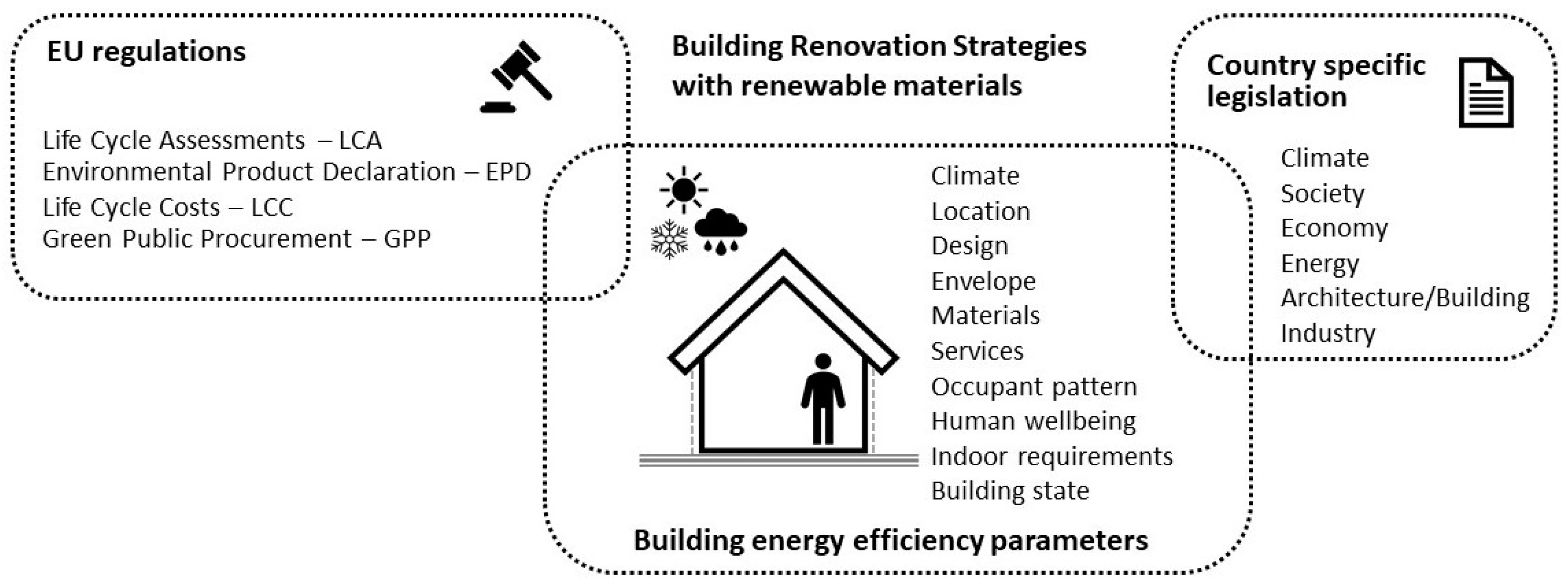



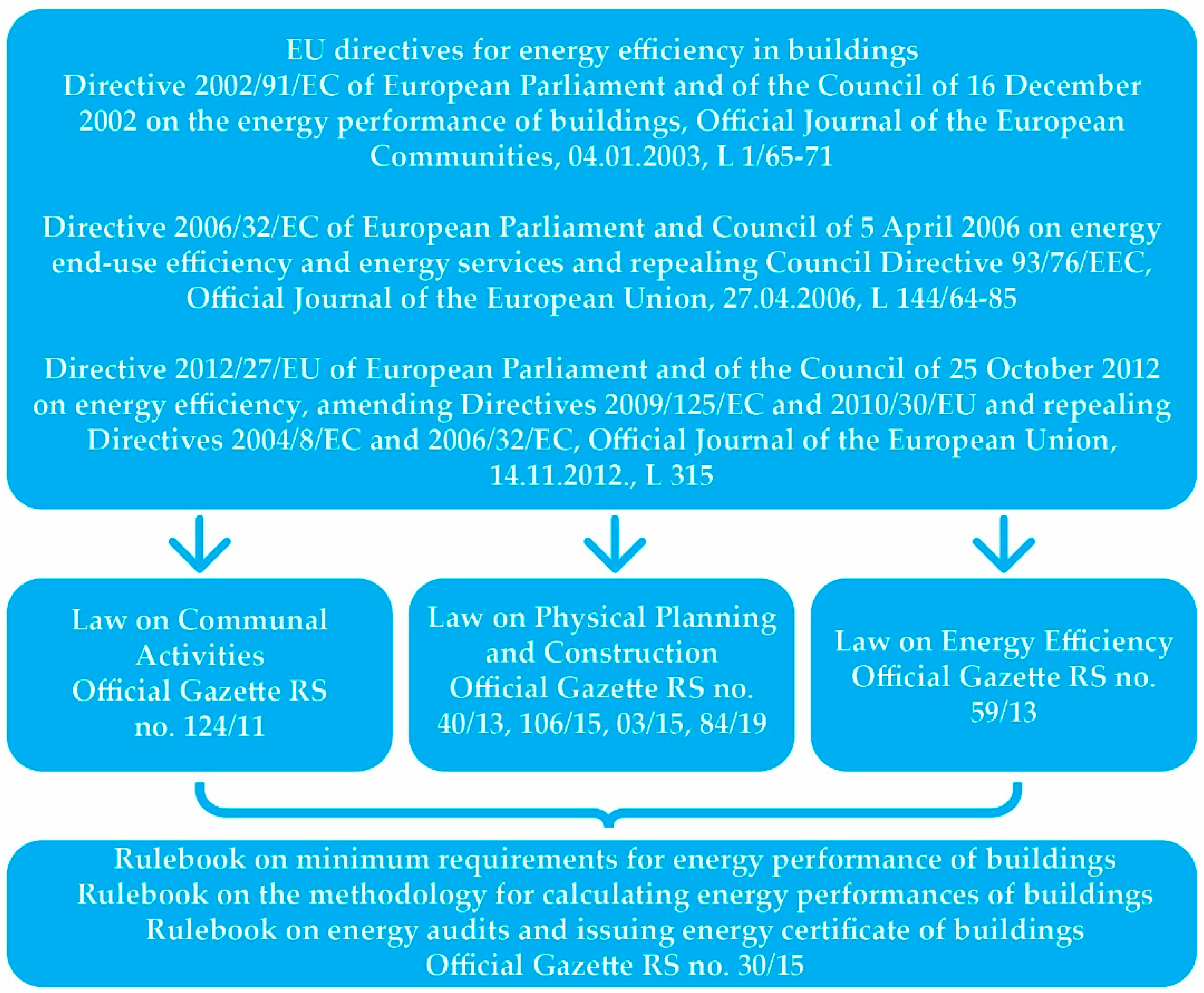
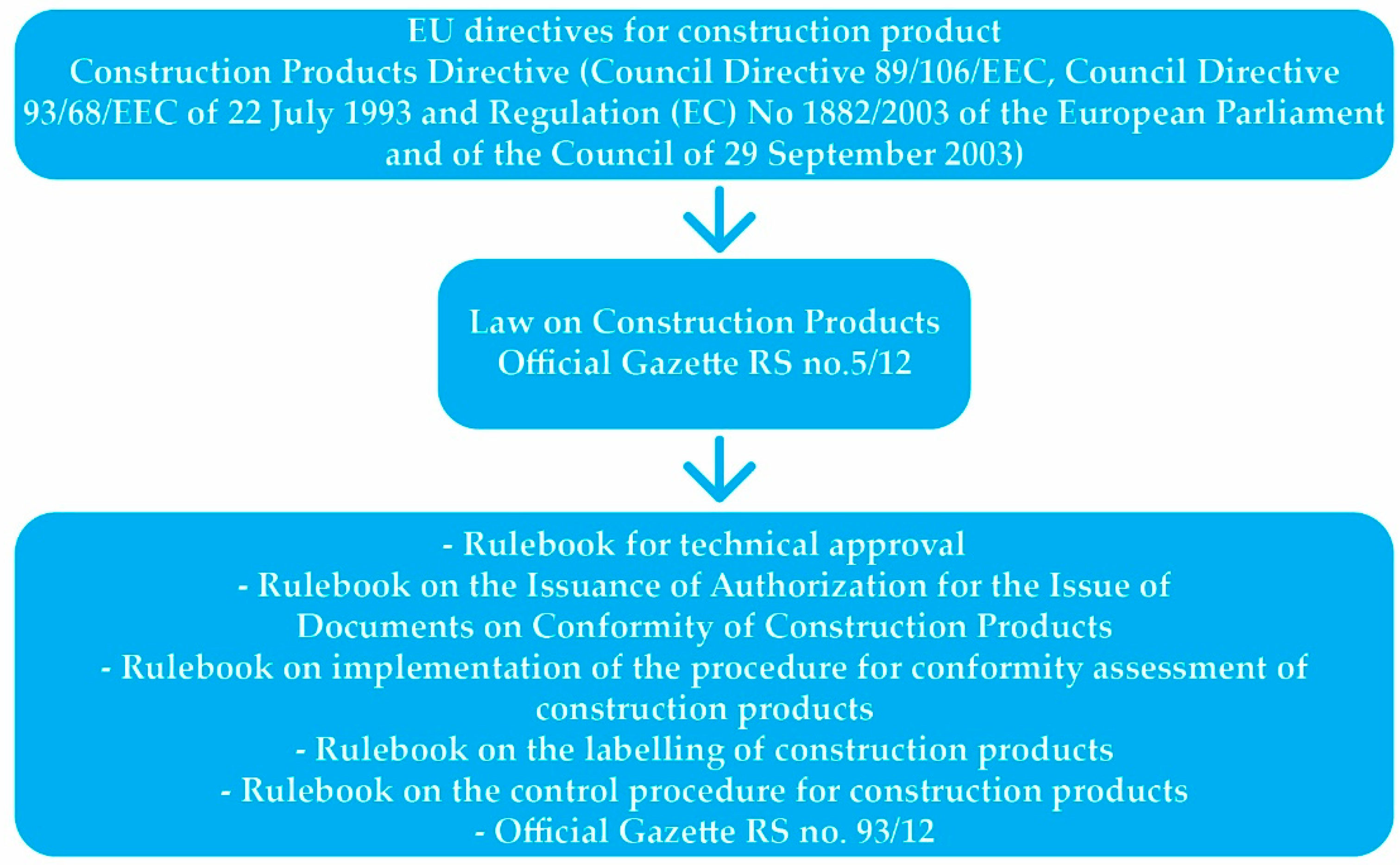

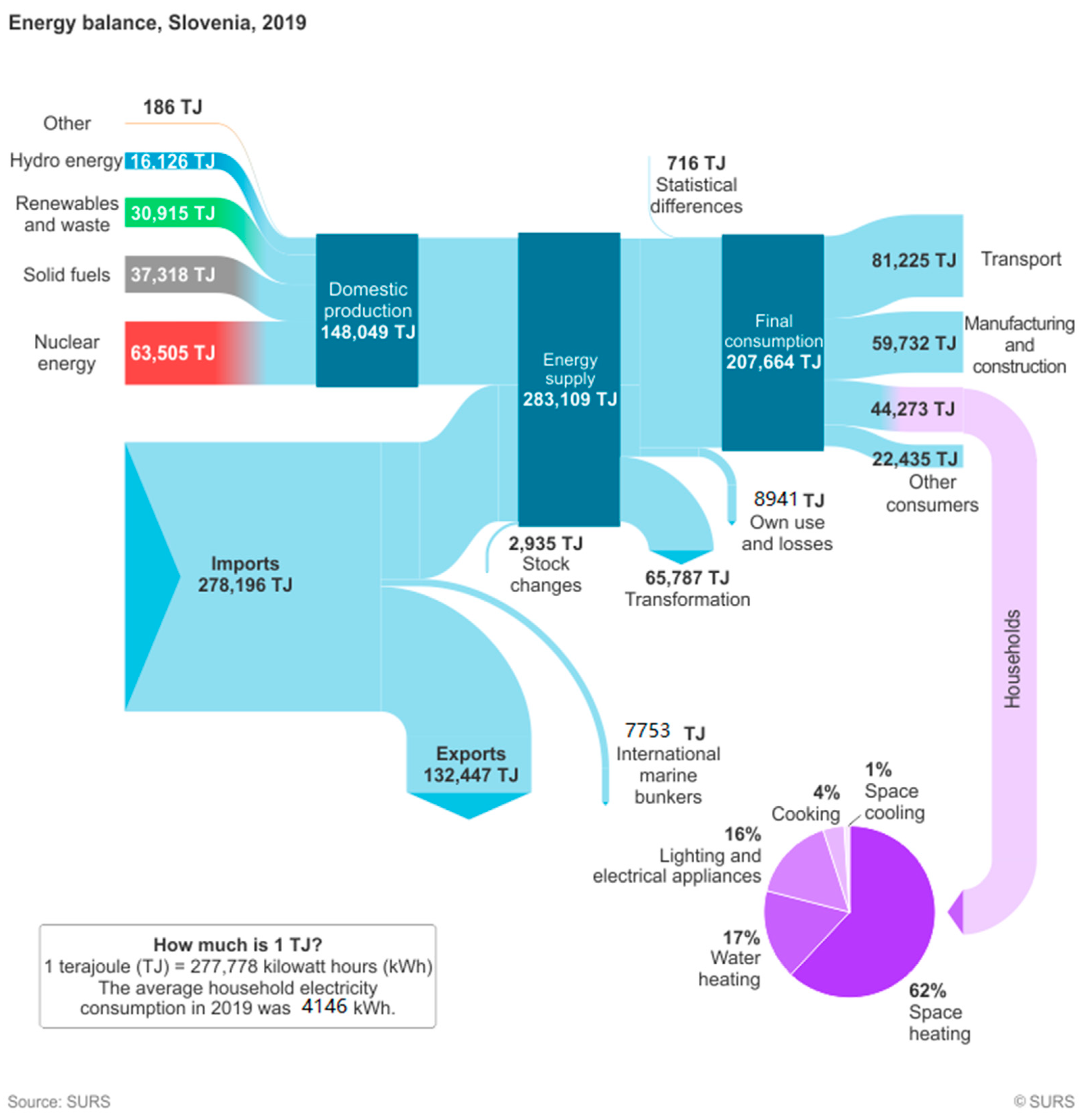
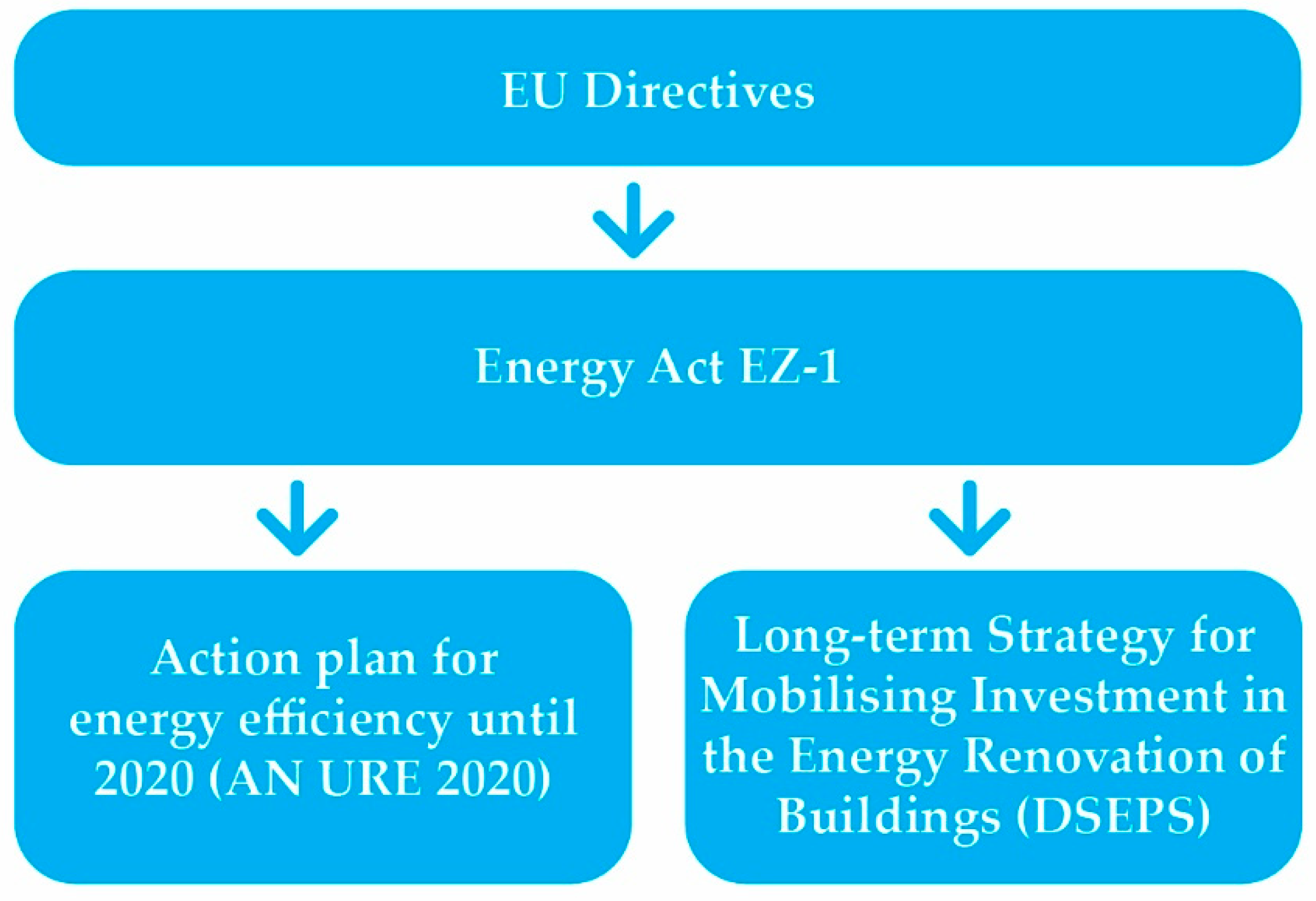
Publisher’s Note: MDPI stays neutral with regard to jurisdictional claims in published maps and institutional affiliations. |
© 2021 by the authors. Licensee MDPI, Basel, Switzerland. This article is an open access article distributed under the terms and conditions of the Creative Commons Attribution (CC BY) license (http://creativecommons.org/licenses/by/4.0/).
Share and Cite
Gajić, D.; Peulić, S.; Mavrič, T.; Sandak, A.; Tavzes, Č.; Malešević, M.; Slijepčević, M. Energy Retrofitting Opportunities Using Renewable Materials—Comparative Analysis of the Current Frameworks in Bosnia-Herzegovina and Slovenia. Sustainability 2021, 13, 603. https://doi.org/10.3390/su13020603
Gajić D, Peulić S, Mavrič T, Sandak A, Tavzes Č, Malešević M, Slijepčević M. Energy Retrofitting Opportunities Using Renewable Materials—Comparative Analysis of the Current Frameworks in Bosnia-Herzegovina and Slovenia. Sustainability. 2021; 13(2):603. https://doi.org/10.3390/su13020603
Chicago/Turabian StyleGajić, Darija, Slobodan Peulić, Tim Mavrič, Anna Sandak, Črtomir Tavzes, Milica Malešević, and Mladen Slijepčević. 2021. "Energy Retrofitting Opportunities Using Renewable Materials—Comparative Analysis of the Current Frameworks in Bosnia-Herzegovina and Slovenia" Sustainability 13, no. 2: 603. https://doi.org/10.3390/su13020603
APA StyleGajić, D., Peulić, S., Mavrič, T., Sandak, A., Tavzes, Č., Malešević, M., & Slijepčević, M. (2021). Energy Retrofitting Opportunities Using Renewable Materials—Comparative Analysis of the Current Frameworks in Bosnia-Herzegovina and Slovenia. Sustainability, 13(2), 603. https://doi.org/10.3390/su13020603






